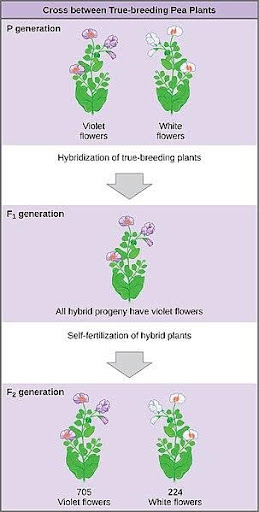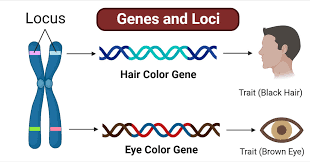2.3: hereditary
1/40
There's no tags or description
Looks like no tags are added yet.
Name | Mastery | Learn | Test | Matching | Spaced |
|---|
No study sessions yet.
41 Terms
what were the early ideas on heredity
people knew sperm + egg carry info and pass traits to offspring
assumed the “Blending Theory”: that traits were a MIX of our parents - like paint, and that their traits would disappear in offspring (no more tall/short , just medium)
this is not the case, because real genetics are like marbles in a jar: traits are passed as separate genes from each parent (NOT MIXED).
even a hidden gene could show up again in later generations and that is why we have variation
who was gregor mendel
1854: he studied plants , focused on peaplants as his main model experiment\
received little attention until rediscovered in 1900s
methodical (step by step), used variables, repeated trials
statistics/probability: counted thousands of plants, 1st to apply math to bio inheritance
open minded: didnt assume old theories
what is mendel’s contribution on the laws of inheritance
didnt know chromosomes were a thing yet
proved blending theory wrong: traits passed as separate units (genes)
some traits are dominant others are recessive'
basis of modern genetics (chromosomes)
didnt know it at the time but proved Segregation: During the formation of gametes, the two alleles for a trait segregate (separate), ensuring that each gamete carries only one allele for each gene.
Independent assortment: Pairs of alleles for different traits segregate independently of one another, a principle that explains how traits can be combined in new ways
why were pea plants a good model system?
self breed —→ true breeding lines
can be cross pollinated
make many generations fast
easy to grow in large #’s
what is true breeding?
group of organisms that are genetically uniform and will produce offspring with identical traits
individuals are homozygous
what type of variation did Mendel use initially? what type of graph does it use?
discontinued variation
traits that come in clear separate categories, no in between
influenced by one gene
flower color: violet OR white (not light purple)
pea shape: round OR unwrinkled (not semi-wrinkled)
bar graph
examples of discontinued variation
blood type, lobed/lobeless ears, eye color, handedness (left OR right)
what did mendels use of discontinued variation show
showed how traits do not blend, rather they kept their distinctiveness, and could be passed on because of how traits could reappear
what is continued variation? what type of graph does it use?
traits expressed along a SPECTRUM without distinct categories, due to combined influence of multiple genes and environmental factors
bell curve middle is average, left and right is extreme, rare cases
examples of continued variation
height, weight, skin color, arm span, intelligence
(T/F): Mendel began with true breeding plants and then cross bred plants with opposite traits
T
P0/Parental Generation + allleles, and what were the offspring
the 2 OG true breeding plants that crossed (violet + white flower)
one parent - violet - is AA (true breeding dom (A only passed), other - white is aa (a only passed) (true breeding recessive)
offspring: AA x aa = 100% Aa (imagine punnet square)

F1 generation + alleles , and their offspring
offspring of p0
found that ALL showed only the dominant trait (violet)
they were hybrid : the offspring of two different purebred parent organisms (heterozygous)
offspring: Aa x Aa = AA, Aa, Aa, aa 1:2:1 genotype
3:1 (3 dom 75%) - 1 recessive (25%)
how did F1 prove blending theory wrong
blending theory would have thought they mixed and formed (light purple), but white disappeared
F2 + alleles. what did F2 show?
offspring of F1
AA, Aa, Aa, aa
recessive trait (white) that disappeared in f1, reappeared in F2 in a 3:1 ratio, proving that traits are not mixed/lost, but REMAINED present in f1
found that traits could be dominant or recessive
dominant vrs recessive
A dominant gene is a variant of a gene that expresses its trait even if only one copy is present in an individual's genotype.
A recessive gene is a variant that is only expressed if two copies of the allele are inherited, one from each parent, because the dominant gene's effect is masked
how many alleles do we get from each parent? how many copies in total for each trait?
1 each parent/ 2 total
2 alleles in a parent separate into different gametes, so each gamete gets one allele - meiosis
AA —> A only gets passed
aa —> a only gets passed
Aa —> 50% A 50% a (some eggs have A, others have a)
alleles of same genes sit on ….
the same locus of homos
the specific, fixed physical location of a gene or other genetic marker on a chromosome

mendel worked with genes that had how many alleles
2
(T/F): many species (humans and dogs), a single gene can have 2+ alleles
T
example blood type (3 alleles)
A, B, O
genotype
2 alleles offspring have for each gene
phenotype
expressed trait (what u see)
(t/f): you can always know genotype from phenotype
F
monohybrid cross
a genetic cross that tracks one single trait + the parents in cross are hybrids (hetero Aa x Aa) for that trait
how many possible outcomes does a monohybrid produce
genotype: 1:2:1 (1 homo dom, 1 homo recessive, 2 heterozygous) = 3 total
phenotype : dominant phenotype and the recessive phenotype. = 2 total (3:1 3 dom offspring and 1 rec offspring, where both heteros show domm trait)
A or a from mom
A or a from dad
AA, Aa, Aa, aa = 3:1
what do monohybrid crosses prove?
law of segregation: alleles separate into gametes and recombine to produce (3:1 dom - rec) ratio in F2
if parents are Aa , gametes have an equal chance of getting each allele (t/f)
t
punnet squares predict …
possible genotypes of offspring and probability of each one
what does test cross do
between an unknown dom (AA or Aa?) and a recessive (aa) to determine unknown genotype
if all kids dom —> parent was AA
if any recessive child appears —> parent was Aa
the average for F2 was 3:1, but not exactly, why?
natural variation: gametes (A or a) meeting each other is random
sample size matters: chance effects have stronger effect when fewer offspring, larger samples average out
tiny experimental errors
exceptions to how alleles interact
incomplete dominance
codominance
multiple alleles
incomplete dominance
neither allele is fully dominant, heterozygote looks like an in between of both parents
snapdragons: CRCR (red) x CWCW (white) = CRCR, 2 CRCW (pink), CWCW
genotype: 1 red: 2 pink: 1 white
alleles remain separate, but red+ white appears
complete dominance
Aa, dom: fully hides recessive in heterozygote
codominance (also what is the universal blood type and why)
both alleles are fully expressed in the heterozygote, not mixed/hidden, both traits visible at same time
ex: MN blood group
LMLM - m only ,,, LNLN - n only
heterozygote = LMLN = both M and N antigens appear
An antigen (A or B) is any substance that can provoke a response from the immune system, causing it to produce antibodies
type O is universal blood type because it has no A or B antigens so immune system does not attack
multiple alleles
more than 2 allele versions exist for the same gene in a population
mendel worked with genes that had only two, buy many genes have more than 2 allele options
ex: blood type IA, IB, IO combinations: many
dihybrid cross
a cross between two heterozygous individuals for TWO trait
one allele from each gene go in one gamete - 4 types of gametes
practice this one : 16 squares look at notes 9 : 3: 3: 1
law of independent assortment states
alleles for diff genes separate randomly/independently
every possible combination of alleles for every gene is likely to occur (metaphase I)
what are the 3 ways for phenotypes
1 gene = 1 phenotype (ex: phease shape R - round, r - wrinkled)
1 gene = multiple phenotypes (PLEIOTROPY) ex: single gene mutation in hemoglobin in red blood cells, sickle cell amenia, marfan syndrome
2+ genes interacting = many phenotypes (POLYGENIC) ex: height, skin color, body weight…..each gene adds a small effect; creating a wide range of possible outcomes bell curve
epistasis
when 1 gene masks another gene (albinism) aa- mask color
environmental variance
portion of phenotypic variation among individuals that is due to non genetic, environmental factors
nutrition, lifestyle, bringing
ex: plants growing in rich soil rhan short plants in bad soil
traits are influenced by both genes and environment (multifactorial traits) (t/f)
T: height (genes + nutrition), skin color ( genes + sun exposure)